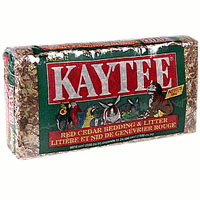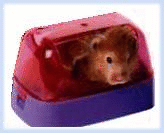
Housing your Hamster (Experienced)
Care Guide / Housing (Book) / Housing (Experince)
Bedding The Wheel
Cleanliness
Housing Tips
Requirements
There are many types of bedding on the market for "small animals". There is corn cob litter (rough, yellowish pellets of corn husk) that are rather rough on paws and better for birds. There is Carefresh (wich causes Bumblefoot, an infected cut in the paw/foot). There is Cedar bedding (reddish-brown, good-smelling bedding) that is very dusty and can hurt your hamsters (and other animals) lungs and throat from the chemicals it produces (see picture)
 . There is pine (white pine shavings) wich is-to put it bluntly-really bad. (click the link to learn more about it and cedar bedding, and why you shouldn't use it) It can cause all sortsa' bad icky poo problems with your hamsters' liver and digestional tract and other internal things if ingested. Also, it can hurt they're feet and is dusty. There is Chlorophyll bedding (pine bedding with green chunks in it) that I tend to stay away from. There is Aspen (wich I recommend mostly). There is also "Fluffy" bedding. This type of bedding is known by hamster owners for its stomach blockages, tendancy to get stuck in cheekpouches, and also its ability to severe hamster limbs. To hear real stories about "Fluffy" (a.k.a. celulose) bedding, go here (http://www.hamsters.co.uk/fluffy.htm).
. There is pine (white pine shavings) wich is-to put it bluntly-really bad. (click the link to learn more about it and cedar bedding, and why you shouldn't use it) It can cause all sortsa' bad icky poo problems with your hamsters' liver and digestional tract and other internal things if ingested. Also, it can hurt they're feet and is dusty. There is Chlorophyll bedding (pine bedding with green chunks in it) that I tend to stay away from. There is Aspen (wich I recommend mostly). There is also "Fluffy" bedding. This type of bedding is known by hamster owners for its stomach blockages, tendancy to get stuck in cheekpouches, and also its ability to severe hamster limbs. To hear real stories about "Fluffy" (a.k.a. celulose) bedding, go here (http://www.hamsters.co.uk/fluffy.htm).
Hamster paws are similar to our hands, and just as delicate (speaking of hamster paws, when my hamster Taco eats, his
pinkies
are pointed upwards. Such a gentleman!). Make sure there is nothing sharp she can cut her paws on, including the rungs of
her
wheel.
Weave paper in the rungs of her wheel so that
she is walking of a flat surface when she is in her wheel, and her legs
don't fall through the rungs of her wheel and scrape her leg.
Wheels seen in this picture are not really enjoyed by hamsters. They are often times too small, not sturdy enough, and chewable. They also hurt your hamsters feet.
Hamsters are very fussy about making nests, and will make
more
than one if needed. Hamsters ask for very little, a
simple diet, a clean draft-free cage, and little more.
Since hamsters are very clean and odorless, they make great indoor pets. Baby hamsters are not housebroken and will soil their cages anywhere, but
I've never met a hamster that didn't respectively go to the bathroom in one corner of its cage.
 See Potty Training to learn everything you wanted to know about potty-training your pet hamster and about hamster potties, how to make your own, litter, and more.
See Potty Training to learn everything you wanted to know about potty-training your pet hamster and about hamster potties, how to make your own, litter, and more.
Food should be fed to your hamster accordingly, and in amounts to keep your hamster the right weight. The perfect food dish it heavy, un-breakable, un-chewable, washable, and un-tippable. Water bottles
 should be cleaned often. An extra water-bottle is a need, and should be kept on hand in case the first one should break or something. Otherwise, your hamster will not have any clean water! Never use a crock or bowl for ANY rodents' water. Bacteria, bugs, and all kinds of nasty things can get in the water. Not to mention it can be tipped over and spilled. Your hamster will hoard food away to someplace convenient, so it is hard to tell how much has been eaten and how much you should give it. For more information, visit the Diet section.
should be cleaned often. An extra water-bottle is a need, and should be kept on hand in case the first one should break or something. Otherwise, your hamster will not have any clean water! Never use a crock or bowl for ANY rodents' water. Bacteria, bugs, and all kinds of nasty things can get in the water. Not to mention it can be tipped over and spilled. Your hamster will hoard food away to someplace convenient, so it is hard to tell how much has been eaten and how much you should give it. For more information, visit the Diet section.
Cages should be constructed with rounded corners
to prevent chewing.
Beware that glass and plastic containers drastically reduce ventilation and can
lead to problems with humidity, temperature and odor concentration.
Hamsters will readily chew through wood, light plastic and soft metal; so recommended caging materials
are wire, stainless steel, durable plastic and glass.
Click HERE for more tips on cages!
Adult hamsters require a minimum floor area of 19 square inches and a cage height of 6 inches. Female breeding hamsters
require much larger areas.
Optimal temperature range for hamsters is between 65o to 80oF, with babies doing best at 70o to
75oF.
The relative humidity should be between 40% and 70%.
Twelve hour light cycles are preferred, with hamsters being
more active during the night. For more requirements, go here.
As a rule of thumb, the cage and accessories should be cleaned thoroughly once to twice weekly. It is much easier if your hamster has a potty and knows how to use it. If so, they litter in its potty should be "combed-through" once a day or once every other day.
An exception to this schedule
is when newborn babies are present; wait until they are at least two weeks old to disturb the cage. Other factors that may
require increased frequency of cleaning are the number of hamsters in the cage, the type of bedding material provided, and the
cage design and size. Cages are sanitized with hot water and nontoxic disinfectant or detergent, then thoroughly rinsed. Water
bottles and food dishes should be cleaned and disinfected daily.
Placement of the Cage
Placement of the hamster cage is almost as important as the cage itself. NEVER place it in front of a vent, radiator, or any sort of air outlet. Even small disturbances in drafts can cause hamsters to become sick or influence negative effects on their behavior. Don't place their cage in a place that gets much sunlight or even unnatural light. Hamsters are nocturnal and so they see much better than humans in the dark, bright lights hurt their eyes and can cause excessive heating of the cage. Don't keep your hamsters cage on the floor (drafts), in places with a lot of traffic (too much commotion), or in places with other violent animals. They should have a dry, clean enviornment at all times. For more information, check out 'Requirements' or 'Basics'.